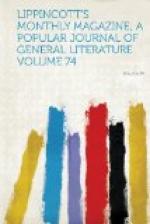[Illustration: Chester, from the Aldford road.]
The river now makes a turn, sweeping along into English ground and making almost a natural moat round Chester, the great Roman camp whose form and intersecting streets still bear the stamp of Roman regularity, and whose history long bore traces of the influence of Roman inflexibility mingled with British dash. The view of the city is fine from the Aldford road (or Old Ford, where a Roman pavement is sometimes visible in the bed of the stream), with the cathedral and St. John’s towering over the peaks and gables that shoot up above the walls. The mention of the ford brings to mind a famous crossing of the river during the civil wars. It was just before the battle of Rowton Moor, which Charles I. watched from the tower that now bears his name; and Sir Marmaduke Langdale, one of his leal soldiers, wishing to send the king notice of his having crossed the Dee at Farndon Bridge and pressing on the Parliamentarians, bade Colonel Shakerley convey the message as speedily as possible. The latter, to avoid the long circuit by the bridge, galloped to the Dee, took a wooden tub used for slaughtering swine, employed “a batting-staff, used for batting of coarse linen,” as an oar, put his servant in the tub, his horse swimming by him, and once across left the tub in charge of the man while he rode to the king, delivered his message and returned to cross over the same way.
[Illustration: Coracles.]
Eaton and Wynnestay are the grandest of the Dee country-seats, though not the most interesting as to architecture. The former, like many Italian houses, has its park open to the public, and is an exception to the jealously-guarded places in most parts of England, but its avenues, rather formal though very magnificent, are approached by lodges. The Wrexham avenue leads to a farmhouse called Belgrave, and here is the christening-point of the new, fashionable London of society, of novelists and of contractors. Another like avenue leads to Pulford, where there is another lodge: a third leads from Grosvenor Bridge to the deer-park, and a fourth to the village of Aldford. The hall is an immense pile, strikingly like, at first glance, the Houses of Parliament, with the Victoria




